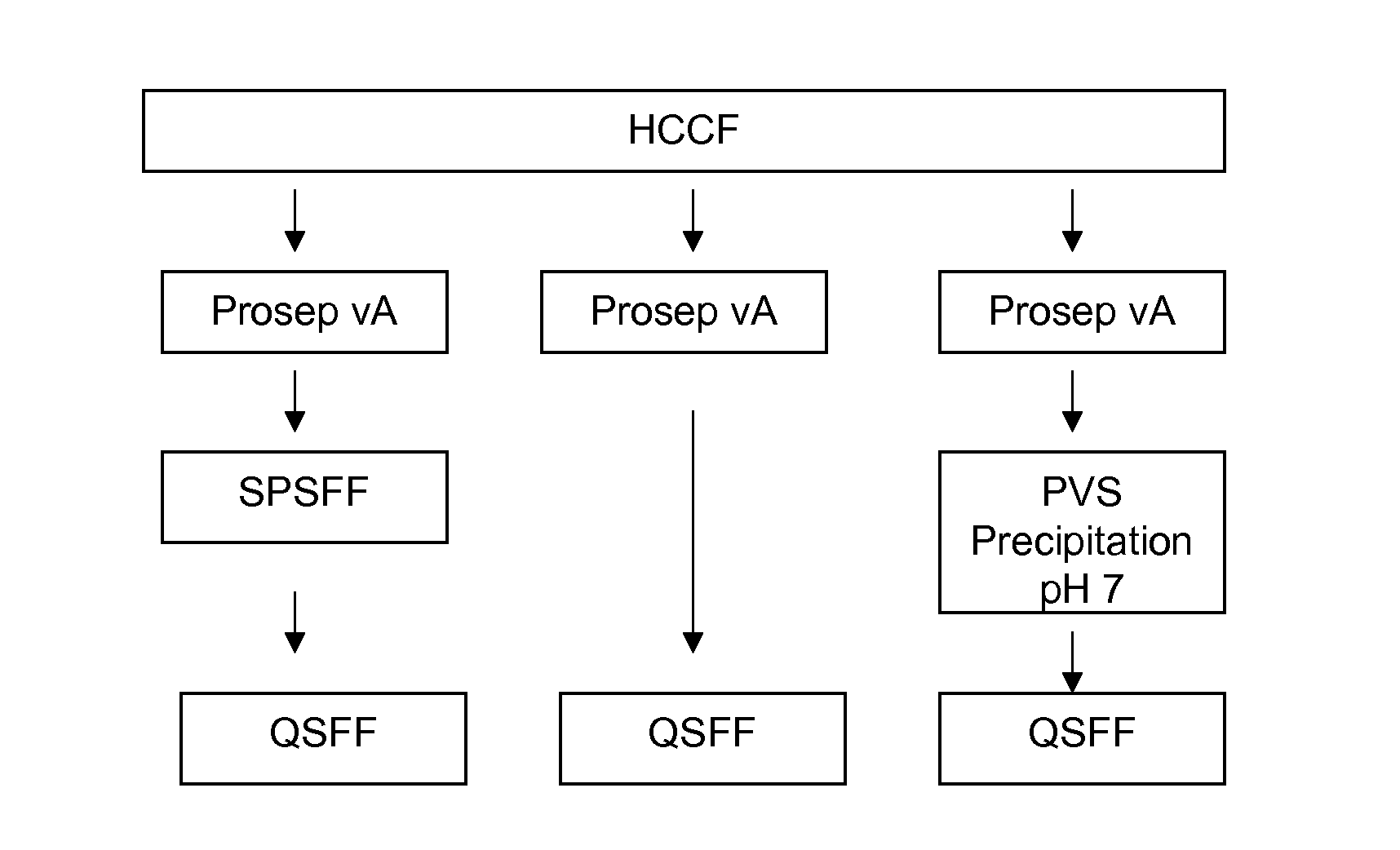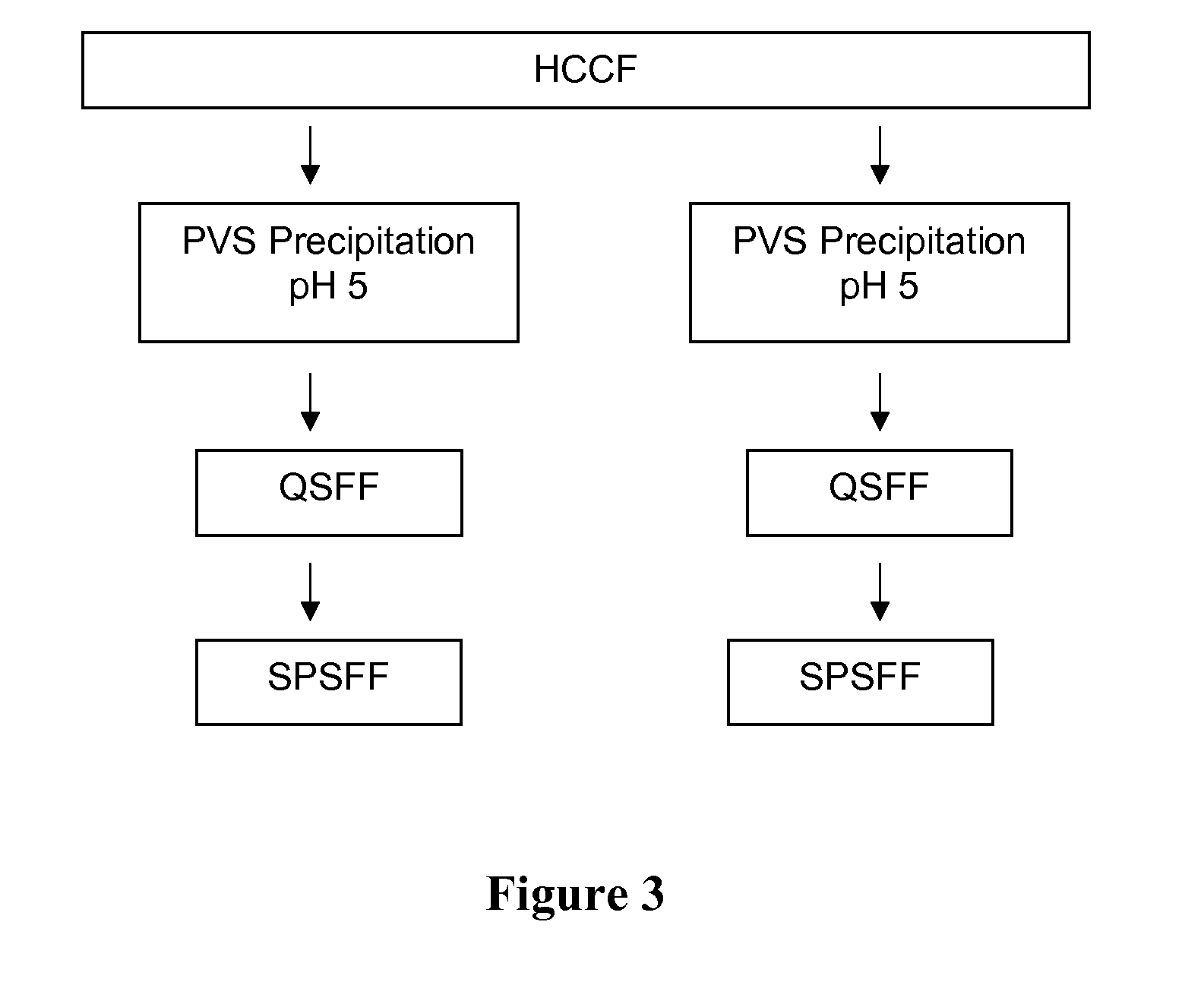Polyelectrolyte precipitation and purification of proteins
- Summary
- Abstract
- Description
- Claims
- Application Information
AI Technical Summary
Problems solved by technology
Method used
Image
Examples
example 1
[0180]The protein A column used Prosep vA resin and was used to purify rhuMab 2H7 present in the HCCF. The column diameter was 2.5 cm and the bed height was 14 cm. The column was operated at a flow rate of 40 CV / h (column volumes per hour). The Prosep vA column was run in multiple cycles (2 cycles). After equilibration, HCCF was applied to the column, and rhuMab 2H7 was retained on the column. The column was then washed with equilibration buffer followed by wash buffer and then again by equilibration buffer. After these washes were complete, elution buffer was applied to the column. Pooling was initiated based on absorbance at 280 nm (0.5 OD) and terminated after 2 column volumes. Regeneration buffer was subsequently applied to the column. Buffer composition and phase durations are indicated in Table 10.
TABLE 10Prosep vA buffer composition and phase durationsPhaseDurationBufferBuffer component(CV)Equilibration25 mM Tris, 25 mM NaCl, 5 mM EDTA,5bufferpH 7.1Loa...
example 2
SPSFF Chromatography
[0183]The cation exchange column used SP Sepharose Fast Flow (SPSFF) resin in bind and elute mode with a gradient elution. The SPSFF column was operated at a flow rate of 150 cm / h. In all cases the bed height was 30 cm. When processing intermediate chromatography pools (Prosep vA and QSFF pools), a 0.66 cm i.d. column was used and the column was loaded to 40 g / L. When processing HCCF, a 0.6-2.2 cm diameter column was used and the column was loaded to 10-40 g / L. In all cases, the load was conditioned to pH 5.0 and a conductivity of about 5.5 mS / cm. Following the load, the column was then washed with equilibration buffer followed by wash buffer and then again by equilibration buffer. After these washes were complete, rhuMab 2H7 was eluted in a gradient from 50 mM acetate to 350 mM acetate over 15 column volumes. Pooling was initiated and terminated based on absorbance at 280 nm (0.5 OD). The column was regenerated and sanitized with 0.5 N sodium hydroxide and store...
example 3
[0184]The anion-exchange column used Q Sepharose Fast Flow (QSFF) resin and was operated in flow-through mode. The QSFF column was operated at a flow rate of 150 cm / h. The column diameter was 0.66 cm and the bed height was 20 cm. The column was equilibrated and loaded at pH 8.0. RhuMab 2H7 antibody flowed through the column, which was then washed with equilibration buffer. Pooling was initiated and terminated based on absorbance at 280 nm (0.5 OD). The column was regenerated and sanitized with 0.5 N sodium hydroxide and stored in 0.1 N sodium hydroxide. Buffer composition and phase durations are indicated in Table 12.
TABLE 12QSFF buffer composition and phase durationsStepBufferCVsEquilibration50 mM Tris, 50 mM Acetate pH 8.08LoadConditioned pool from previous stepto 40 g / L capacityWash 150 mM Tris, 50 mM Acetate pH 8.05Sanitization0.5 M NaOH4Storage0.1 M NaOH3
PUM
| Property | Measurement | Unit |
|---|---|---|
| Fraction | aaaaa | aaaaa |
| Fraction | aaaaa | aaaaa |
| Mass | aaaaa | aaaaa |
Abstract
Description
Claims
Application Information
 Login to View More
Login to View More - R&D
- Intellectual Property
- Life Sciences
- Materials
- Tech Scout
- Unparalleled Data Quality
- Higher Quality Content
- 60% Fewer Hallucinations
Browse by: Latest US Patents, China's latest patents, Technical Efficacy Thesaurus, Application Domain, Technology Topic, Popular Technical Reports.
© 2025 PatSnap. All rights reserved.Legal|Privacy policy|Modern Slavery Act Transparency Statement|Sitemap|About US| Contact US: help@patsnap.com



